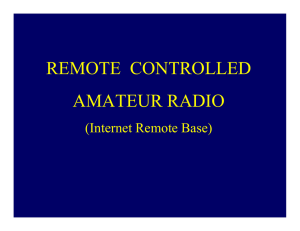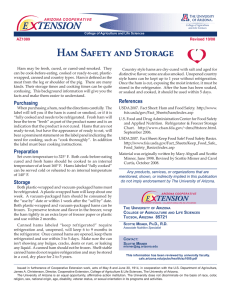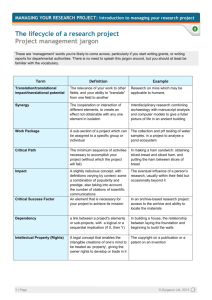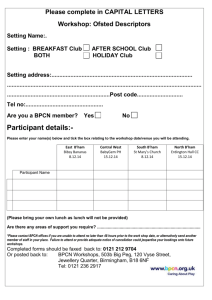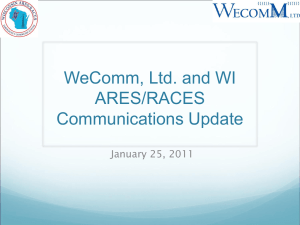Ham Ways A Primer
advertisement
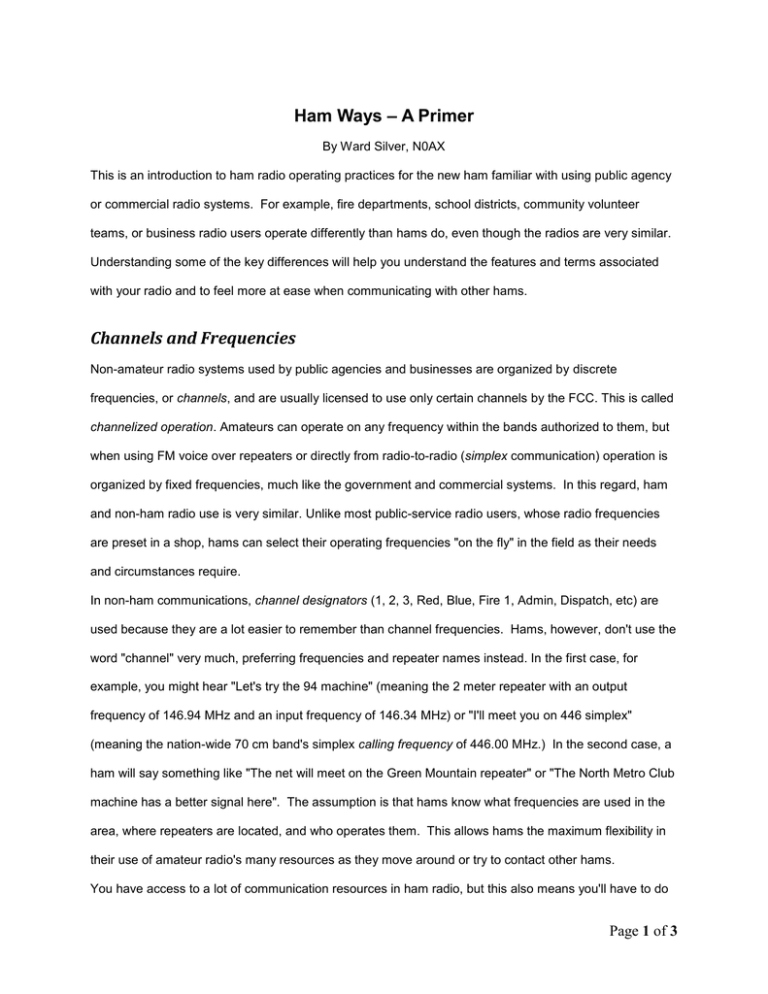
Ham Ways – A Primer By Ward Silver, N0AX This is an introduction to ham radio operating practices for the new ham familiar with using public agency or commercial radio systems. For example, fire departments, school districts, community volunteer teams, or business radio users operate differently than hams do, even though the radios are very similar. Understanding some of the key differences will help you understand the features and terms associated with your radio and to feel more at ease when communicating with other hams. Channels and Frequencies Non-amateur radio systems used by public agencies and businesses are organized by discrete frequencies, or channels, and are usually licensed to use only certain channels by the FCC. This is called channelized operation. Amateurs can operate on any frequency within the bands authorized to them, but when using FM voice over repeaters or directly from radio-to-radio (simplex communication) operation is organized by fixed frequencies, much like the government and commercial systems. In this regard, ham and non-ham radio use is very similar. Unlike most public-service radio users, whose radio frequencies are preset in a shop, hams can select their operating frequencies "on the fly" in the field as their needs and circumstances require. In non-ham communications, channel designators (1, 2, 3, Red, Blue, Fire 1, Admin, Dispatch, etc) are used because they are a lot easier to remember than channel frequencies. Hams, however, don't use the word "channel" very much, preferring frequencies and repeater names instead. In the first case, for example, you might hear "Let's try the 94 machine" (meaning the 2 meter repeater with an output frequency of 146.94 MHz and an input frequency of 146.34 MHz) or "I'll meet you on 446 simplex" (meaning the nation-wide 70 cm band's simplex calling frequency of 446.00 MHz.) In the second case, a ham will say something like "The net will meet on the Green Mountain repeater" or "The North Metro Club machine has a better signal here". The assumption is that hams know what frequencies are used in the area, where repeaters are located, and who operates them. This allows hams the maximum flexibility in their use of amateur radio's many resources as they move around or try to contact other hams. You have access to a lot of communication resources in ham radio, but this also means you'll have to do Page 1 of 3 a little homework with friends and clubs! Luckily, directories are available to help individual hams find their way around. The ARRL publishes the nationwide ARRL Repeater Directory, for example. If you live in or near a large city, one of the clubs may publish a local or regional directory—ask your club, emcomm team, one of the volunteer license examiners, or inquire at a ham radio store. Your emcomm team or club will also be of great help to you in getting familiar with ham customs in your area. Call Signs Hams use their call signs a lot because they are required to as a means of identifying themselves on the air and they are proud of their license (you should be, too!). You may have used tactical call signs, such as "Ambulance 1" or "Red Team" or "Main Office". These are also used in amateur radio during exercises and emergency communications, but the ham's call sign must be used for regular identification (or "ID") on a regular basis. Most hams assume they are on a first-name-and-call sign basis with any other ham; "Rick KUØW" or "Gayle KG7ZZZ". (Hams put a slash through the zero to distinguish it from a capital O.) Know your call sign and practice using standard phonetics when you say it over the air and when listening to the call sign of other hams. In ham radio, your call sign is your name, so it's good manners to learn and use the calls of other hams. Business Communications The FCC prohibits hams from engaging in business communications over the air. That includes any transactions that can be conducted over a business or agency channel. The only exceptions are for purely personal, non-profit activities. For example, a ham can use a repeater auto-patch to dial up a doctor's office and change an appointment, but can not use the airwaves to advertise a used-equipment business. If there is a ham station where you work, such as an Emergency Operations Center, you can't use it as part of your professional duties except during emergencies. You can, of course, use it for personal enjoyment while you're not "on the clock". The more you use ham radio, the more comfortable you'll be and the more you'll get back from your license. Dispatch, Trunking, and Talk Groups Unlike most commercial and public safety systems, ham repeaters and simplex channels have no Page 2 of 3 dispatcher or controller to direct communications. The exception is nets, on-the-air meetings during which a net control station or NCS keeps order. Hams do not use trunked or trunking systems, either. If your work or organization assigned you and your radio specific "talk groups" or "work groups", you were using a trunked system. In a trunking system, a central control computer moves the frequencies of all the radios around to make optimum use of a few channels. This is not necessary for hams. If you are part of a team or group, you'll identify the activity by the group's name, such as "The Centerville ARES Net", but your call sign is still your primary identification. Calling Another Ham This part may finally start to sound familiar! You may call any other ham at any time on any repeater or simplex channel, as long as you do not interfere with an ongoing contact. If you don't know whether the ham is listening on a specific channel, wait until the channel is clear and then call as follows, "W1AW (the station you want to contact) this is KC2ABC, Kilo Charlie Two Alpha Bravo Charlie, over." (Listening to other hams, you'll hear a number of variations on this basic theme.) If they don't respond, try again. If you decide to stop calling, just announce, "This is KC2ABC clear" to let other hams know you're done. To break into an ongoing conversation or to ask if you can call another ham, just give your call sign once during a pause. It's acceptable to add the word "break", such as "KC2ABC break", but do not say "break" more than once or use any other kind of operating code. If the other hams hear you, they'll either ask you to stand by ("KC2ABC, stand by") or stop talking and let you take a turn ("KC2ABC, this is W6AM, go ahead"). There is much more information in the ARRL Operating Manual about how amateurs actually operate. That is also a good reference to look up the abbreviations and procedural signals hams use every day. For example, hams don't use "10 codes", such as "10-4". If you join in a few conversations or a net or "round table" contact, listen carefully, and participate regularly, you'll soon relax and sound like a veteran. Don't forget to help other newcomers that will be learning to fit in, just like you did! Page 3 of 3

